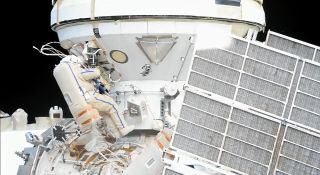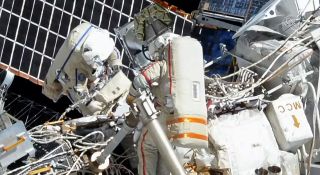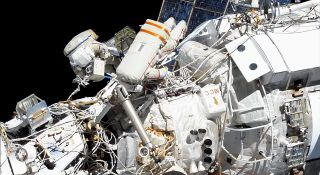Cosmonauts on spacewalk run power and data to new space station module
Two cosmonauts completed the first in a series of spacewalks needed to outfit a newly-added Russian module to the International Space Station.
Expedition 65 flight engineers Oleg Novitskiy and Pyotr Dubrov of the Russian space agency Roscosmos on Friday (Sept. 2) connected power and data cables for the new multipurpose laboratory module (MLM), also referred to as "Nauka" (or "Science" in Russian).
Novitskiy and Dubrov began the seven-hour, 54-minute spacewalk at 10:41 a.m. EDT (1441 GMT) by opening the hatch on the Poisk mini-research module located adjacent to the Nauka module on the Russian segment of the space station. After gathering their tools, the cosmonauts deployed the Strela telescoping boom, a 46-foot-long (14 meters) manually operated crane that they used to traverse the station's Russian modules.
Video: Cosmonauts spacewalk outside Nauka module in these amazing views
Related: Tour Russia's new Nauka space station module with these astronaut home movies

Retrieving two bundles of four cables each, the spacewalkers connected the U.S. operating segment's power supply to a patch panel on Nauka and to an interface panel on the Zarya functional cargo block. The cosmonauts ran into some difficulty removing protective end caps from some of the cables but were able to get all of them freed and the cables plugged in.
The eight cables tied Nauka into the U.S. solar panel-fed system that provides electricity for the entire space station. Electrical checks conducted after the cables were in place showed a good connection and power flowing as expected.
Novitskiy and Dubrov also began the routing of an ethernet cable to Nauka and partially installed a new handrail to ease future spacewalks.
Get the Space.com Newsletter
Breaking space news, the latest updates on rocket launches, skywatching events and more!

Launched on July 21 and autonomously docked to the space station eight days later, the Nauka module will provide an expanded area to conduct science, as well as serve as a docking port and airlock for Russian spacewalks. The MLM will also house additional crew quarters and a toilet for the space station's residents.
Running slightly behind schedule as a result of the extra work needed to free the cable caps, Novitskiy and Dubrov were instructed by Moscow Mission Control to defer installing two handrails and three biological science experiments to a later spacewalk. Novitskiy and Dubrov wrapped their work by stowing the Strela boom.

The spacewalk ended at 6:35 p.m. EDT (2235 GMT), as the airlock hatch on the Poisk module was closed.
Friday's spacewalk was the second for both Novitskiy and Dubrov, who previously performed their first extravehicular activity (EVA) together in June. The two are scheduled to work outside the space station again to continue the outfitting of Nauka on Thursday (Sept. 9).
Novitskiy, who was designated extravehicular crew member 1 (EV1), wore the Russian Orlan spacesuit with red stripes. Dubrov wore a spacesuit with blue stripes as EV2.

This was the 242nd EVA in support of International Space Station assembly, maintenance and upgrades and the 10th spacewalk outside the outpost in 2021.
Robert Pearlman is a Space.com contributing writer and the editor of collectSPACE.com, a Space.com partner site and the leading space history news publication. Follow collectSPACE on Facebook and on Twitter at @collectSPACE. Follow us @Spacedotcom and Facebook.
Join our Space Forums to keep talking space on the latest missions, night sky and more! And if you have a news tip, correction or comment, let us know at: community@space.com.

Robert Pearlman is a space historian, journalist and the founder and editor of collectSPACE.com, an online publication and community devoted to space history with a particular focus on how and where space exploration intersects with pop culture. Pearlman is also a contributing writer for Space.com and co-author of "Space Stations: The Art, Science, and Reality of Working in Space” published by Smithsonian Books in 2018. He previously developed online content for the National Space Society and Apollo 11 moonwalker Buzz Aldrin, helped establish the space tourism company Space Adventures and currently serves on the History Committee of the American Astronautical Society, the advisory committee for The Mars Generation and leadership board of For All Moonkind. In 2009, he was inducted into the U.S. Space Camp Hall of Fame in Huntsville, Alabama. In 2021, he was honored by the American Astronautical Society with the Ordway Award for Sustained Excellence in Spaceflight History.
